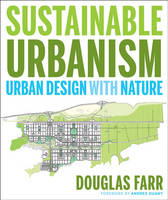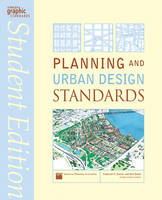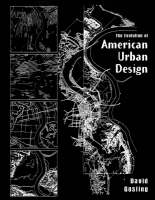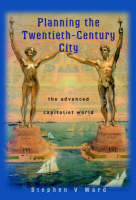Sustainable Urbanism
 -15%
portes grátis
-15%
portes grátis
Sustainable Urbanism
Urban Design With Nature
Farr, Douglas
John Wiley & Sons Inc
01/2008
352
Dura
Inglês
9780471777519
15 a 20 dias
812
Descrição não disponível.
Foreword (Andres Duany). Preface.
How to use this book.
Acknowledgments.
Part One The Case for Sustainable Urbanism.
Chapter 1: The Built Environment: Where We Are Today.
The American Lifestyle on the Wrong Course.
Pioneering Reforms: Setting the Stage for Sustainable Urbanism.
Chapter 2: Sustainable Urbanism: Where We Need to Go.
Sustainable Urbanism: The Grand Unification.
The Three Steps of Sustainable Urbanism.
Part Two Implementing Sustainable Urbanism.
Chapter 3: Leadership and Communications.
Leadership Talking Points for Sustainable Urbanism (Jim Hackler and Irina Woelfle)
The Power of Paired Choices.
Implementation Agendas for Leaders.
Chapter 4: The Process and Tools for Implementing Sustainable Urbanism.
RFQ for Sustainable Urbanist Professionals.
Benchmarking Municipal Sustainability: The Santa Monica Sustainable City Plan (City of Santa Monica).
Documenting Community Preference in Form and Sustainability: Image Preference Survey (IPS) (Christina Anderson)
Conducting a Charrette (Bill Lennertz)
Shaping Sustainable Neighborhoods with the Toledo Smart Neighborhood Analysis Protocol (SNAP) (Carolee Kokola).
A Sustainable Urbanist Neighborhood Plan: Toledo SNAP (Carolee Kokola).
Regulating Plan and Form-Based Code (Christina Anderson).
Incorporating Sustainability through Codes, Covenants, and Restrictions (CC&Rs) (Dan Slone).
RFP for a Sustainable Urbanist Developer (City of Victoria, British Columbia).
Part Three Emerging Thresholds of Sustainable Urbanism.
Chapter 5: Increasing Sustainability Through Density.
Explaining Density.
Illustrating Density.
The Transect of the Everyday.
Water and the Density Debate (Lynn Richards).
Transit Supportive Densities.
Chapter 6: Sustainable Corridors.
The Sustainable Corridor (Doug Farr, Leslie Oberholtzer, and Christian Schaller).
The Integration of Transportation, Land Use, and Technology (Shelley Poticha).
Biodiversity Corridors (Rebecca L. Kihslinger, Jessica Wilkinson, and James McElfish).
Chapter 7: Sustainable Neighborhoods.
Neighborhood Diagrams.
Neighborhood Definition (Victor Dover and Jason King).
Neighborhood Completeness (Eliot Allen and Doug Farr).
Neighborhood Housing (Laurie Volk and Todd Zimmerman).
Car-Free Housing.
Neighborhood Retail (Robert J. Gibbs).
Economic Benefits of Locally Owned Stores (Matt Cunningham).
Third Places.
Healthy Neighborhoods (Melanie Simmons, Kathy Baughman McLeod,and Jason Hight).
Walkable Streets and Networks (Dan Burden).
Complete Streets (Fred Dock).
Universal Basic Home Access (Eleanor Smith).
Managing Travel Demand (Jeffery Tumlin).
Car Sharing (Jeffery Tumlin0.
Chapter 8: Biophilia.
Open Space (Carolee Kokola).
Public Darkness (Nancy Clanton and Todd Givler).
Stormwater Systems (Jim Patchett and Tom Price).
Food Production (Lynn Peemoeller and Jim Slama, with Cathy Morgan).
Outdoor Wastewater Treatment (Thomas E. Ennis).
Indoor Wastewater Treatment (John Todd Ecological Design).
Chapter 9: High-Performance Buildings and Infrastructure.
The Impact of Planning on Building Energy Usage (Alan Chalifoux).
2030 Challenge (Ed Mazria).
High-Performance Infrastructure (Hillary Brown).
Large District Energy Systems (Doug Newman and Robert Thornton, John Kelly, and Adam Lund).
The 2030 Community Challenge: Economic Growth with Sustainable Urbanism.
Part Four Case Studies in Sustainable Urbanism.
Chapter 10: Lessons Learned from Sustainable Urbanism.
Built Infill.
BedZED: London, England.
Glenwood Park: Atlanta, Georgia, United States.
Holiday Neighborhood: Boulder, Colorado, United States.
Christie Walk: Adelaide, Australia.
Newington: Sydney, Australia.
High Point: Seattle, Washington, United States.
Built Greenfield.
Upton: Northampton, England.
Kronsberg: Hannover, Germany.
Loreto Bay: Baja California Sur, Mexico.
Civano: Tucson, Arizona, United States.
Poundbury: Dorchester, England.
Chapter 11: State of the Art in Unbuilt Sustainable Urbanism.
Unbuilt Infill.
Dockside Green: Victoria, Canada.
Lloyd Crossing: Portland, Oregon, United States.
Z-Squared: London, England.
New Railroad Square: Santa Rosa, California, United States.
Uptown Normal: Normal, Illinois, United States.
Unbuilt Greenfield.
Dongtan: Shanghai, China.
Galisteo Basin Preserve: Santa Fe, New Mexico, United States.
Pulelehua: Maui, Hawaii, United States.
Coyote Valley: San Jose, California, United States.
Scales of Intervention.
Epilogue.
Glossary.
Index.
How to use this book.
Acknowledgments.
Part One The Case for Sustainable Urbanism.
Chapter 1: The Built Environment: Where We Are Today.
The American Lifestyle on the Wrong Course.
Pioneering Reforms: Setting the Stage for Sustainable Urbanism.
Chapter 2: Sustainable Urbanism: Where We Need to Go.
Sustainable Urbanism: The Grand Unification.
The Three Steps of Sustainable Urbanism.
Part Two Implementing Sustainable Urbanism.
Chapter 3: Leadership and Communications.
Leadership Talking Points for Sustainable Urbanism (Jim Hackler and Irina Woelfle)
The Power of Paired Choices.
Implementation Agendas for Leaders.
Chapter 4: The Process and Tools for Implementing Sustainable Urbanism.
RFQ for Sustainable Urbanist Professionals.
Benchmarking Municipal Sustainability: The Santa Monica Sustainable City Plan (City of Santa Monica).
Documenting Community Preference in Form and Sustainability: Image Preference Survey (IPS) (Christina Anderson)
Conducting a Charrette (Bill Lennertz)
Shaping Sustainable Neighborhoods with the Toledo Smart Neighborhood Analysis Protocol (SNAP) (Carolee Kokola).
A Sustainable Urbanist Neighborhood Plan: Toledo SNAP (Carolee Kokola).
Regulating Plan and Form-Based Code (Christina Anderson).
Incorporating Sustainability through Codes, Covenants, and Restrictions (CC&Rs) (Dan Slone).
RFP for a Sustainable Urbanist Developer (City of Victoria, British Columbia).
Part Three Emerging Thresholds of Sustainable Urbanism.
Chapter 5: Increasing Sustainability Through Density.
Explaining Density.
Illustrating Density.
The Transect of the Everyday.
Water and the Density Debate (Lynn Richards).
Transit Supportive Densities.
Chapter 6: Sustainable Corridors.
The Sustainable Corridor (Doug Farr, Leslie Oberholtzer, and Christian Schaller).
The Integration of Transportation, Land Use, and Technology (Shelley Poticha).
Biodiversity Corridors (Rebecca L. Kihslinger, Jessica Wilkinson, and James McElfish).
Chapter 7: Sustainable Neighborhoods.
Neighborhood Diagrams.
Neighborhood Definition (Victor Dover and Jason King).
Neighborhood Completeness (Eliot Allen and Doug Farr).
Neighborhood Housing (Laurie Volk and Todd Zimmerman).
Car-Free Housing.
Neighborhood Retail (Robert J. Gibbs).
Economic Benefits of Locally Owned Stores (Matt Cunningham).
Third Places.
Healthy Neighborhoods (Melanie Simmons, Kathy Baughman McLeod,and Jason Hight).
Walkable Streets and Networks (Dan Burden).
Complete Streets (Fred Dock).
Universal Basic Home Access (Eleanor Smith).
Managing Travel Demand (Jeffery Tumlin).
Car Sharing (Jeffery Tumlin0.
Chapter 8: Biophilia.
Open Space (Carolee Kokola).
Public Darkness (Nancy Clanton and Todd Givler).
Stormwater Systems (Jim Patchett and Tom Price).
Food Production (Lynn Peemoeller and Jim Slama, with Cathy Morgan).
Outdoor Wastewater Treatment (Thomas E. Ennis).
Indoor Wastewater Treatment (John Todd Ecological Design).
Chapter 9: High-Performance Buildings and Infrastructure.
The Impact of Planning on Building Energy Usage (Alan Chalifoux).
2030 Challenge (Ed Mazria).
High-Performance Infrastructure (Hillary Brown).
Large District Energy Systems (Doug Newman and Robert Thornton, John Kelly, and Adam Lund).
The 2030 Community Challenge: Economic Growth with Sustainable Urbanism.
Part Four Case Studies in Sustainable Urbanism.
Chapter 10: Lessons Learned from Sustainable Urbanism.
Built Infill.
BedZED: London, England.
Glenwood Park: Atlanta, Georgia, United States.
Holiday Neighborhood: Boulder, Colorado, United States.
Christie Walk: Adelaide, Australia.
Newington: Sydney, Australia.
High Point: Seattle, Washington, United States.
Built Greenfield.
Upton: Northampton, England.
Kronsberg: Hannover, Germany.
Loreto Bay: Baja California Sur, Mexico.
Civano: Tucson, Arizona, United States.
Poundbury: Dorchester, England.
Chapter 11: State of the Art in Unbuilt Sustainable Urbanism.
Unbuilt Infill.
Dockside Green: Victoria, Canada.
Lloyd Crossing: Portland, Oregon, United States.
Z-Squared: London, England.
New Railroad Square: Santa Rosa, California, United States.
Uptown Normal: Normal, Illinois, United States.
Unbuilt Greenfield.
Dongtan: Shanghai, China.
Galisteo Basin Preserve: Santa Fe, New Mexico, United States.
Pulelehua: Maui, Hawaii, United States.
Coyote Valley: San Jose, California, United States.
Scales of Intervention.
Epilogue.
Glossary.
Index.
Este título pertence ao(s) assunto(s) indicados(s). Para ver outros títulos clique no assunto desejado.
Andres Duany, urban design, sustainable urban design, Sustainable Urbanism, Sustainable, Urban Design, Planning, Architecture, 2030 Community Challenge, 2030 Communities Campaign, 2030, green, towns, cities, neighborhood diagram, neighborhood design, eco-city, eco-cities, ecological, nature, natural design, urbanism, walkability, walkable, smart growth, LEED-ND, new-urbanism, new-urbanist, mcharg, land-use, land development, LEED, USGBC, U.S. Green Building Council, open-space, parks, natural systems, environmentalism, environment, storm water, high-performance infrastructure, green infrastructure, dual-use infrastructure, neighborhood, density, transit corridor, sustainable corridor, public health, obesity, indoor air quality, biophilia, patterns, thresholds, implementation, leadership
Foreword (Andres Duany). Preface.
How to use this book.
Acknowledgments.
Part One The Case for Sustainable Urbanism.
Chapter 1: The Built Environment: Where We Are Today.
The American Lifestyle on the Wrong Course.
Pioneering Reforms: Setting the Stage for Sustainable Urbanism.
Chapter 2: Sustainable Urbanism: Where We Need to Go.
Sustainable Urbanism: The Grand Unification.
The Three Steps of Sustainable Urbanism.
Part Two Implementing Sustainable Urbanism.
Chapter 3: Leadership and Communications.
Leadership Talking Points for Sustainable Urbanism (Jim Hackler and Irina Woelfle)
The Power of Paired Choices.
Implementation Agendas for Leaders.
Chapter 4: The Process and Tools for Implementing Sustainable Urbanism.
RFQ for Sustainable Urbanist Professionals.
Benchmarking Municipal Sustainability: The Santa Monica Sustainable City Plan (City of Santa Monica).
Documenting Community Preference in Form and Sustainability: Image Preference Survey (IPS) (Christina Anderson)
Conducting a Charrette (Bill Lennertz)
Shaping Sustainable Neighborhoods with the Toledo Smart Neighborhood Analysis Protocol (SNAP) (Carolee Kokola).
A Sustainable Urbanist Neighborhood Plan: Toledo SNAP (Carolee Kokola).
Regulating Plan and Form-Based Code (Christina Anderson).
Incorporating Sustainability through Codes, Covenants, and Restrictions (CC&Rs) (Dan Slone).
RFP for a Sustainable Urbanist Developer (City of Victoria, British Columbia).
Part Three Emerging Thresholds of Sustainable Urbanism.
Chapter 5: Increasing Sustainability Through Density.
Explaining Density.
Illustrating Density.
The Transect of the Everyday.
Water and the Density Debate (Lynn Richards).
Transit Supportive Densities.
Chapter 6: Sustainable Corridors.
The Sustainable Corridor (Doug Farr, Leslie Oberholtzer, and Christian Schaller).
The Integration of Transportation, Land Use, and Technology (Shelley Poticha).
Biodiversity Corridors (Rebecca L. Kihslinger, Jessica Wilkinson, and James McElfish).
Chapter 7: Sustainable Neighborhoods.
Neighborhood Diagrams.
Neighborhood Definition (Victor Dover and Jason King).
Neighborhood Completeness (Eliot Allen and Doug Farr).
Neighborhood Housing (Laurie Volk and Todd Zimmerman).
Car-Free Housing.
Neighborhood Retail (Robert J. Gibbs).
Economic Benefits of Locally Owned Stores (Matt Cunningham).
Third Places.
Healthy Neighborhoods (Melanie Simmons, Kathy Baughman McLeod,and Jason Hight).
Walkable Streets and Networks (Dan Burden).
Complete Streets (Fred Dock).
Universal Basic Home Access (Eleanor Smith).
Managing Travel Demand (Jeffery Tumlin).
Car Sharing (Jeffery Tumlin0.
Chapter 8: Biophilia.
Open Space (Carolee Kokola).
Public Darkness (Nancy Clanton and Todd Givler).
Stormwater Systems (Jim Patchett and Tom Price).
Food Production (Lynn Peemoeller and Jim Slama, with Cathy Morgan).
Outdoor Wastewater Treatment (Thomas E. Ennis).
Indoor Wastewater Treatment (John Todd Ecological Design).
Chapter 9: High-Performance Buildings and Infrastructure.
The Impact of Planning on Building Energy Usage (Alan Chalifoux).
2030 Challenge (Ed Mazria).
High-Performance Infrastructure (Hillary Brown).
Large District Energy Systems (Doug Newman and Robert Thornton, John Kelly, and Adam Lund).
The 2030 Community Challenge: Economic Growth with Sustainable Urbanism.
Part Four Case Studies in Sustainable Urbanism.
Chapter 10: Lessons Learned from Sustainable Urbanism.
Built Infill.
BedZED: London, England.
Glenwood Park: Atlanta, Georgia, United States.
Holiday Neighborhood: Boulder, Colorado, United States.
Christie Walk: Adelaide, Australia.
Newington: Sydney, Australia.
High Point: Seattle, Washington, United States.
Built Greenfield.
Upton: Northampton, England.
Kronsberg: Hannover, Germany.
Loreto Bay: Baja California Sur, Mexico.
Civano: Tucson, Arizona, United States.
Poundbury: Dorchester, England.
Chapter 11: State of the Art in Unbuilt Sustainable Urbanism.
Unbuilt Infill.
Dockside Green: Victoria, Canada.
Lloyd Crossing: Portland, Oregon, United States.
Z-Squared: London, England.
New Railroad Square: Santa Rosa, California, United States.
Uptown Normal: Normal, Illinois, United States.
Unbuilt Greenfield.
Dongtan: Shanghai, China.
Galisteo Basin Preserve: Santa Fe, New Mexico, United States.
Pulelehua: Maui, Hawaii, United States.
Coyote Valley: San Jose, California, United States.
Scales of Intervention.
Epilogue.
Glossary.
Index.
How to use this book.
Acknowledgments.
Part One The Case for Sustainable Urbanism.
Chapter 1: The Built Environment: Where We Are Today.
The American Lifestyle on the Wrong Course.
Pioneering Reforms: Setting the Stage for Sustainable Urbanism.
Chapter 2: Sustainable Urbanism: Where We Need to Go.
Sustainable Urbanism: The Grand Unification.
The Three Steps of Sustainable Urbanism.
Part Two Implementing Sustainable Urbanism.
Chapter 3: Leadership and Communications.
Leadership Talking Points for Sustainable Urbanism (Jim Hackler and Irina Woelfle)
The Power of Paired Choices.
Implementation Agendas for Leaders.
Chapter 4: The Process and Tools for Implementing Sustainable Urbanism.
RFQ for Sustainable Urbanist Professionals.
Benchmarking Municipal Sustainability: The Santa Monica Sustainable City Plan (City of Santa Monica).
Documenting Community Preference in Form and Sustainability: Image Preference Survey (IPS) (Christina Anderson)
Conducting a Charrette (Bill Lennertz)
Shaping Sustainable Neighborhoods with the Toledo Smart Neighborhood Analysis Protocol (SNAP) (Carolee Kokola).
A Sustainable Urbanist Neighborhood Plan: Toledo SNAP (Carolee Kokola).
Regulating Plan and Form-Based Code (Christina Anderson).
Incorporating Sustainability through Codes, Covenants, and Restrictions (CC&Rs) (Dan Slone).
RFP for a Sustainable Urbanist Developer (City of Victoria, British Columbia).
Part Three Emerging Thresholds of Sustainable Urbanism.
Chapter 5: Increasing Sustainability Through Density.
Explaining Density.
Illustrating Density.
The Transect of the Everyday.
Water and the Density Debate (Lynn Richards).
Transit Supportive Densities.
Chapter 6: Sustainable Corridors.
The Sustainable Corridor (Doug Farr, Leslie Oberholtzer, and Christian Schaller).
The Integration of Transportation, Land Use, and Technology (Shelley Poticha).
Biodiversity Corridors (Rebecca L. Kihslinger, Jessica Wilkinson, and James McElfish).
Chapter 7: Sustainable Neighborhoods.
Neighborhood Diagrams.
Neighborhood Definition (Victor Dover and Jason King).
Neighborhood Completeness (Eliot Allen and Doug Farr).
Neighborhood Housing (Laurie Volk and Todd Zimmerman).
Car-Free Housing.
Neighborhood Retail (Robert J. Gibbs).
Economic Benefits of Locally Owned Stores (Matt Cunningham).
Third Places.
Healthy Neighborhoods (Melanie Simmons, Kathy Baughman McLeod,and Jason Hight).
Walkable Streets and Networks (Dan Burden).
Complete Streets (Fred Dock).
Universal Basic Home Access (Eleanor Smith).
Managing Travel Demand (Jeffery Tumlin).
Car Sharing (Jeffery Tumlin0.
Chapter 8: Biophilia.
Open Space (Carolee Kokola).
Public Darkness (Nancy Clanton and Todd Givler).
Stormwater Systems (Jim Patchett and Tom Price).
Food Production (Lynn Peemoeller and Jim Slama, with Cathy Morgan).
Outdoor Wastewater Treatment (Thomas E. Ennis).
Indoor Wastewater Treatment (John Todd Ecological Design).
Chapter 9: High-Performance Buildings and Infrastructure.
The Impact of Planning on Building Energy Usage (Alan Chalifoux).
2030 Challenge (Ed Mazria).
High-Performance Infrastructure (Hillary Brown).
Large District Energy Systems (Doug Newman and Robert Thornton, John Kelly, and Adam Lund).
The 2030 Community Challenge: Economic Growth with Sustainable Urbanism.
Part Four Case Studies in Sustainable Urbanism.
Chapter 10: Lessons Learned from Sustainable Urbanism.
Built Infill.
BedZED: London, England.
Glenwood Park: Atlanta, Georgia, United States.
Holiday Neighborhood: Boulder, Colorado, United States.
Christie Walk: Adelaide, Australia.
Newington: Sydney, Australia.
High Point: Seattle, Washington, United States.
Built Greenfield.
Upton: Northampton, England.
Kronsberg: Hannover, Germany.
Loreto Bay: Baja California Sur, Mexico.
Civano: Tucson, Arizona, United States.
Poundbury: Dorchester, England.
Chapter 11: State of the Art in Unbuilt Sustainable Urbanism.
Unbuilt Infill.
Dockside Green: Victoria, Canada.
Lloyd Crossing: Portland, Oregon, United States.
Z-Squared: London, England.
New Railroad Square: Santa Rosa, California, United States.
Uptown Normal: Normal, Illinois, United States.
Unbuilt Greenfield.
Dongtan: Shanghai, China.
Galisteo Basin Preserve: Santa Fe, New Mexico, United States.
Pulelehua: Maui, Hawaii, United States.
Coyote Valley: San Jose, California, United States.
Scales of Intervention.
Epilogue.
Glossary.
Index.
Este título pertence ao(s) assunto(s) indicados(s). Para ver outros títulos clique no assunto desejado.
Andres Duany, urban design, sustainable urban design, Sustainable Urbanism, Sustainable, Urban Design, Planning, Architecture, 2030 Community Challenge, 2030 Communities Campaign, 2030, green, towns, cities, neighborhood diagram, neighborhood design, eco-city, eco-cities, ecological, nature, natural design, urbanism, walkability, walkable, smart growth, LEED-ND, new-urbanism, new-urbanist, mcharg, land-use, land development, LEED, USGBC, U.S. Green Building Council, open-space, parks, natural systems, environmentalism, environment, storm water, high-performance infrastructure, green infrastructure, dual-use infrastructure, neighborhood, density, transit corridor, sustainable corridor, public health, obesity, indoor air quality, biophilia, patterns, thresholds, implementation, leadership




